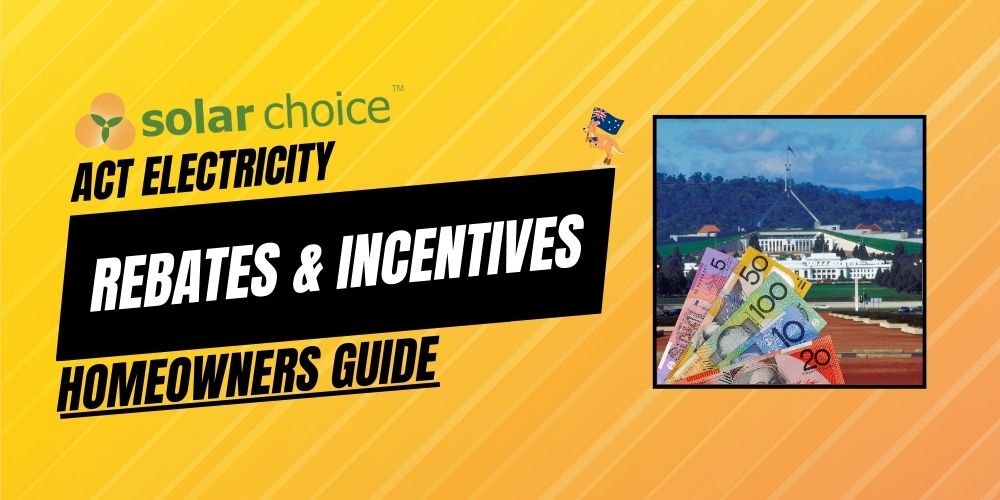Electricity prices in the Canberra, ACT have been volatile, with costs rising in recent years despite strong renewable generation. To help households and small businesses manage bills, both the Australian Government and the ACT Government provide a range of rebates, concessions, and credits.
This independent Solar Choice guide explains every electricity rebate and incentive available in the ACT in 2025–26—who can claim them, how much they’re worth, and how to apply.
Looking to compare plans? See electricity prices and providers in the ACT.
Summary of ACT Electricity Rebates (2025–26)
| Rebate / Program | Amount | Who Can Get It |
| National Energy Bill Relief – Households | $150 (two × $75 credits) | All ACT households with an electricity account |
| National Energy Bill Relief – Small Business | $150 | Small businesses using <100 MWh per year |
| ACT Utilities Concession | Up to $750 per year | Eligible concession card households |
| Medical Heating and Cooling Concession | Up to $750 per year (combined with Utilities Concession) | Concession households with medical needs |
| ACT Cost of Living Concession | $50–$100 credit per year | Pensioner and low-income households |
| Feed-in Tariffs (FiTs) | 6–12¢/kWh (retail); legacy premium FiTs for pre-2011 systems | Households exporting solar |
Federal Rebates & Incentives for ACT (2025)
National Energy Bill Relief – Households
A universal credit applied to reduce bills across Australia.
- Amount: $150 in 2025–26 (two × $75 credits).
- Eligibility: All ACT households with an active electricity account.
- How to apply: Applied automatically to electricity bills by your retailer.
- More info: Energy.gov.au – National Energy Bill Relief
National Energy Bill Relief – Small Business
Small businesses also receive bill support.
- Amount: $150 credit in 2025–26.
- Eligibility: ACT businesses with usage under 100 MWh per year (small sites, roughly <$25k annual bills).
- How to apply: Applied automatically by your retailer.
ACT Rebates & Concessions
ACT Utilities Concession
The main concession in the ACT, designed to assist with the cost of electricity, gas, water, and sewerage.
- Amount: Up to $750 per year (adjusted annually for CPI). Paid in daily amounts and credited to your electricity account.
- Eligibility: Available to concession card holders, including Pensioner Concession Card, Health Care Card, and DVA Gold Card holders.
- How to apply: Apply through your electricity retailer (e.g. ActewAGL) by providing concession details. More info: ACT Government – Utilities Concession.
Medical Heating and Cooling Concession
Provides extra support for households where a resident has a medical condition requiring cooling or heating.
- Amount: Included within the Utilities Concession cap (up to $750 total per year).
- Eligibility: Concession card holders with a medical certificate verifying the condition.
- How to apply: Apply through your electricity retailer with supporting documentation.
ACT Cost of Living Concession
A smaller, separate payment to assist with household costs.
- Amount: $50–$100 per year depending on eligibility and household type. Paid directly once a year.
- Eligibility: Low-income households, pensioners, and concession card holders in the ACT.
- How to apply: Apply via ACT Revenue Office – Cost of Living Concession.
Feed-in Tariffs in the ACT
The ACT was an early leader in solar feed-in tariffs (FiTs).
- Current FiTs: Retailers in the ACT set voluntary feed-in tariffs, typically between 6¢ and 12¢/kWh in 2025.
- Legacy schemes: Households that installed solar before 2011 may still receive premium tariffs (40–50¢/kWh) until 2031 under the ACT’s original gross FiT scheme. New customers cannot access these rates.
For more information, see:
How to Apply for ACT Electricity Rebates
- Concession holders: Provide concession details to your electricity retailer to access the Utilities Concession and Medical Concession.
- Cost of Living Concession: Apply annually through the ACT Revenue Office.
- Federal Bill Relief: Applied automatically—no application required.
How to Maximise Energy Savings in the ACT
- Check your eligibility – Many households miss out because concession details aren’t linked to their electricity account.
- Apply for all concessions – You may qualify for both the Utilities Concession and Cost of Living Concession.
- Compare energy providers – See ACT electricity comparison.
- Maximise solar benefits – Review the best ACT feed-in tariffs.
- Consider energy efficiency upgrades – The ACT Government runs occasional rebates for efficiency measures (check act.gov.au).
Final Word
ACT households benefit from a combination of federal bill relief, the ACT Utilities Concession, the Medical Heating and Cooling Concession, and the Cost of Living Concession. Together, these programs can significantly reduce annual energy bills. By making sure you’re registered with your retailer, applying for all eligible concessions, and comparing energy plans, you can make the most of the support available in 2025–26.
FAQs
Can I get both the Utilities Concession and the Cost of Living Concession?
Yes, if you meet the eligibility requirements for both.
Do rebates still apply if I have solar credits on my bill?
Yes. Rebates are applied regardless of whether your bill is offset by feed-in tariffs.
Do I need to reapply every year?
The Utilities Concession is ongoing once approved, but the Cost of Living Concession usually requires an annual application.
Are there rebates for gas in the ACT?
Yes. The Utilities Concession covers electricity, gas, water, and sewerage charges in one combined payment.
- Air Conditioners Compared Australia | Independent Homeowners Guide (2026) - 23 December, 2025
- Changes To Cheaper Home Batteries Program | Homeowners Guide | Coming 1 May 2026 - 15 December, 2025
- ReadySteadyPlug EV Charging for Apartments: An Independent Review by Solar Choice - 12 December, 2025
